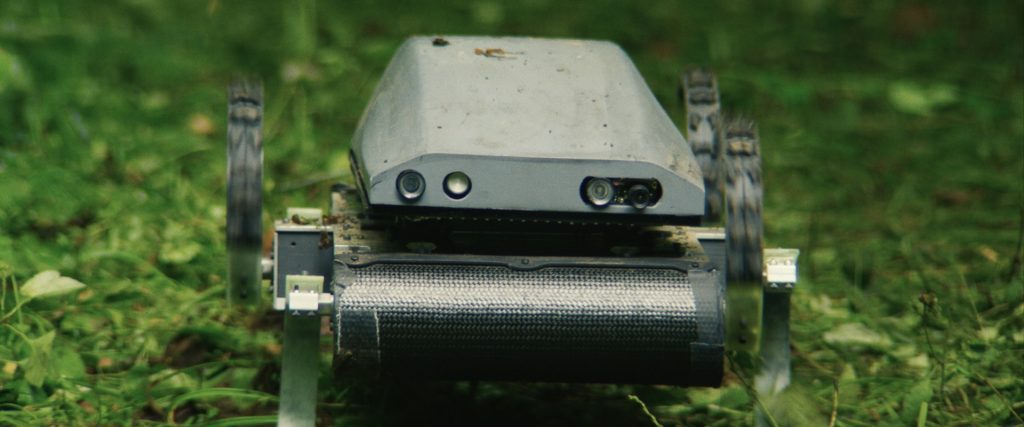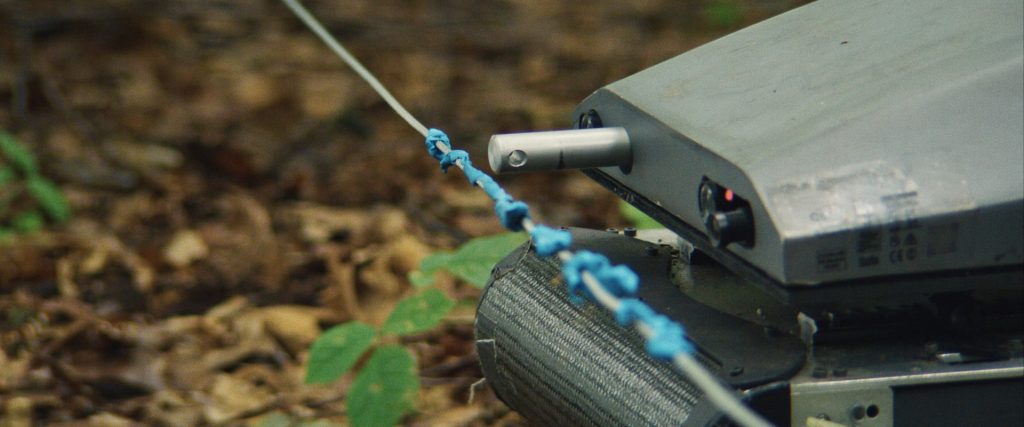
In the new film Lapsis, writer/director Noah Hutton interrogates the relationship between technology, corporations and everyday workers trying to make ends meet. Taking place in a “parallel present,” gig workers are paid to lay cable through the wilderness, connecting ominous, humming cubes that form the basis of a quantum computing network. And to complete the look of this not-so-other-worldly film, the cablers’ competition is played by a real robot that Penn Engineers may recognize: Kod*Lab’s biologically inspired hexapod, RHex.
Lapsis is the story of Ray, an average Joe who reluctantly takes a cabling job to support his sick younger brother. Once on the job, he discovers that automatic cablers — played by RHex — undercut their human counterparts’ pay by tirelessly trudging through the forest, cables in tow.
Hutton says Lapsis is based on his experience as a post-grad in 2009 during the U.S. financial crisis and his experience caring for his own sick brother. Given the underlying reality of the film, he knew he wanted real robots on screen.
“At first, I was inspired by those automated food delivery carts I had seen in viral videos,” Hutton says, “But in my movie, these robots would be out in the forest and those carts seemed a little dinky. I needed something all-terrain that could navigate the environment.”
After some research, Hutton found some videos of RHex in action and learned more about the project. With a large, flat back onto which sensors and other equipment can be mounted and springy legs instead of wheels, Kod*Lab researchers designed the robot to navigate rough, unpredictable terrain. Since the automatic cablers in Lapsis needed to inexorably make their way through a forest’s underbrush, Hutton thought RHex seemed like just the robot to get the job done.
“RHex felt utilitarian,” Hutton says. “I liked that it didn’t have the creepy factor you often feel with humanoid or dog-like robots but it still felt like something biological. I had never seen robotic legs like that and all of these traits made it feel like a real character in my story.”
Hutton reached out to Dan Koditschek, Alfred Fitler Moore Professor in the Department of Electrical and Systems Engineering and Director of the Kod*Lab, who was very receptive to the idea of using RHex in an indie movie. Koditschek watched Hutton’s previous films and asked his own questions about the role of the automatic cablers in Lapsis and how the RHex would be portrayed.
“It was a really nice beginning to the collaboration,” Hutton comments, “because Dan took me seriously as an artist. I felt lucky to have found his lab.”
During the film’s pre-production phase in 2019, Hutton visited the Penn Engineering Research and Collaboration Hub (PERCH) at the Pennovation Center, and spent the day with Koditschek and members of the Kod*Lab. While there, Hutton watched students demo the robot and he learned how its unique design allows it to navigate difficult terrain. Hutton also watched videos of RHex in the desert, which inspired him to think about how RHex could be outfitted for the big screen.
“The cool thing about RHex is how customizable it is,” Hutton says. For Lapsis, Hutton’s production designer, Alexander Linde, added a shell on top of RHex’s back to store tools and sensors that the robots to use during their missions.

Beyond building specialized gear for the robot, meeting with Koditschek and his students in the Kod*Lab inspired Hutton to revise the script for Lapsis to incorporate RHex’s real-world capabilities. Hutton fine-tuned how the automatic cablers explored their forest world and how human cablers could derail or trap them in order to beat the robots to the next quantum box.
“Once we figured out what obstacles RHex’s legs could jump out of or get over, we recalibrated what those scenes would look like in the script,” Hutton says.
Once everything was ready on paper, there were still logistical challenges in getting RHex camera-ready. Not wanting to disrupt ongoing research, the Kod*Lab temporarily recalled two RHex units it had loaned to Chicago’s Museum of Science and Industry. Lab member and doctoral candidate Abriana Stewart-Height then went to work returning these display pieces to full functionality.
“After several days of maintenance and a robot hike in Philly’s Wissahickon Valley Park, one of the main concerns was dust or dirt getting into the electronics within the robot’s frame,” says Stewart-Height, “so I designed and 3D-printed caps to plug into several of the holes in the RHex platform.”
This additional preparation came in handy; rain plagued the upstate New York set for the first few days of shooting, giving the Kod*Lab’s robot operators small windows to nail their takes. But between shooting, recharging batteries and conducting various field repairs, both the students and robots proved up to the task.
“Every time we needed RHex to do something, it did it, without mistake. It was pretty magical,” Hutton says.
Working on Lapsis was a learning experience for both Hutton and members of the Kod*Lab. Beyond the technical challenges of getting their robots to perform, there were philosophical questions of how they would be portrayed.
“There is this negative stereotype about robots from those outside of the robotics community,” says Stewart-Height. “I was personally against using any robots in the lab for a movie if they were going to be the villain.”
“The issue lies in who is designing the robots and what are they designing the robots to do, which the movie sheds light on,” she says.
Ultimately, the collaboration was the kind of dialog between the worlds of science and art that informs both sides.
“I’m always grateful to be able to learn about other people’s work, especially artists,” says Diego Caporale, another doctoral candidate and Kod*Lab member who worked on set. “Noah and the rest of the crew listened to our feedback about the robots’ capabilities and role in the film, including us in the filmmaking process instead of just having us as robot handlers.”
“It is important for engineers and scientists to engage with the community and keep them informed so they can be proactive,” he says. “Film, and art in general, can be a direct connection to that social consciousness.”
Stories like Lapsis are a reminder that science is not an objective, value-free practice and all innovation should be interrogated as to whom it truly benefits. Rather than creating a reductive “evil robot” movie, Hutton’s film captures the tension between the potential benefits of technology and the dangers that creep in as that technology is applied.
“Humans are often forced to scapegoat the image of technology that they see in front of them, such as the automatic cablers,” Hutton says. “We criticize the end result when really, the problem is further upstream than that. It’s the corporate structures that put the robots into the field while also not providing, for example, health care or basic protections for independent contractors. With Lapsis, I want to imagine a possible future, or should I say, a possible alternative present, where a person doesn’t need to feel like they are powerless because they don’t have access to elite technology.”
“In the end,” he says, “this story centers on the power of collective action, of people coming together with purpose. When we do that, anything is possible.”
